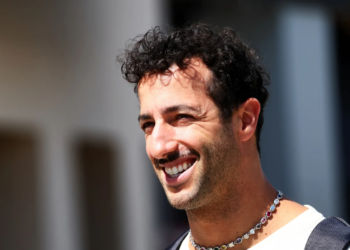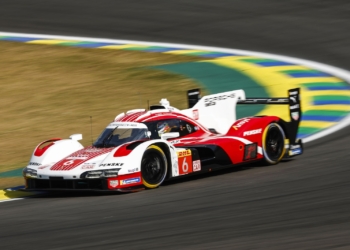You’ll be aware by now – to borrow some poetic words from Clive James’s brilliant commentary on the 1982 F1 season review – that the final two laps of last weekend’s Canadian Grand Prix were an optical illusion.
The race actually contained 68 laps, even if to the unaided eye of the average earthling it had appeared to contain 70.
And as you’ll also be aware by now, it was for a simple reason. The chequered flag to end the race was waved a lap early in error.
And the effect of this was doubled, as to quote Article 43.2 of F1’s sporting regulations, “should for any reason the end-of-race signal be given before the leading car completes the scheduled number of laps, or the prescribed time has been completed, the race will be deemed to have finished when the leading car last crossed the Line before the signal was given.” So in other words, similar to what happens with a red flag stoppage, the result is taken from the lap before the error.
It was to the good fortune of all concerned that the changes to the outcome between 68 and 70 laps were minor – Sergio Perez lost a place gained but it was outside of the points. Daniel Ricciardo lost fastest lap to his team-mate.
A meagre additional crumb of comfort for all concerned is that the goof up is far from unprecedented. The most recent instance before last weekend was relatively recent indeed, the 2014 Chinese Grand Prix when victor Lewis Hamilton got the chequered flag a lap early. And again even though Lewis and everyone else continued to the end of the scheduled distance the official result was based on where they were with two laps remaining.
As for how such a thing could happen, especially in this age of precise computerised timing, on that occasion in China it turned out that – to borrow the catchphrase of a notorious UK newspaper columnist – you couldn’t make it up. It was reported that it was “understood that the mistake happened when the clerk of the course unfurled the flag to test it.” Oops.
As was the case in Canada they had the fortune that the only position change after the result was declared was outside the points.
Going further back in the 1985 British Grand Prix the chequered flag was also shown a lap early, that time to leader and victor Alain Prost, and it was all down to a bit of old-fashioned British incompetence. The official on the line assumed his manual lap chart was correct even though he had the computerised system close to hand. Trouble is his manual chart wasn’t correct. Prost however, as ever leaving nothing to chance, completed the final lap anyway just as victor Sebastian Vettel did last Sunday.
Drivers can get it wrong too – in the German round at Hockenheim a couple of years back the self-same Vettel somehow resolved to slow for the race’s end a lap early. Fortunately he realised his error before he’d lost any places.
A meagre additional crumb of comfort for all concerned is that the goof up is far from unprecedented. The most recent instance before last weekend was relatively recent indeed, the 2014 Chinese Grand Prix when victor Lewis Hamilton got the chequered flag a lap early.
My personal favourite tale comes from 1982 and the Swiss Grand Prix at Dijon – in effect a second French race on the calendar. Then the home ticket of Alain Prost in the Renault had led for much of the way, but in the late laps second-placed Keke Rosberg’s Williams was hurtling down on him at a rapid rate.
As they were set to begin their penultimate tour the gap was down to a few cars’ lengths, but Williams’ team manager Peter Collins spotted something. An official at the start line apparently was all set to wave the chequered flag two laps early – presumably to the aid of the home team! Collins however sprinted over and managed to distract the said official long enough to allow Prost and Rosberg to flash by once more.
Then, on what all assumed was the final lap, Rosberg indeed found a way by to lead but come the end of the lap there was no chequered flag. According to Maurice Hamilton at the time, “the officials, now thoroughly harassed, were gesticulating with their colleagues in the control tower and, in so doing, missed Rosberg…”. Some dryly noted that instead they might have been minded now to put the flag out late in case Prost caught up again. Whatever, Rosberg kept going until he saw a flag which duly arrived a lap later.
But for all that these things may amuse the consequences of such an error, including the one at Montreal, could have been grave. Literally.
Vettel was right to fear that fans thinking the race was over could have invaded the track, as they did at this venue in 1995, while all were continuing at full pelt. There is a real danger too that if some cars had slowed and some not one could have flipped over the back of another.
This is why you alter such set procedures at your peril; the risk is that not everyone will react the same way.
It has been pointed out too that under the rules all flags should be obeyed, so really upon passing a chequered flag all cars should have slowed and returned to parc ferme, rather than carried on as they did. This is said not to criticise the drivers involved, rather to underline the confusion created.
For all that these things may amuse the consequences of such an error could have been grave. Literally. Vettel was right to fear that fans thinking the race was over could have invaded the track. There is a real danger too that if some cars had slowed and some not one could have flipped over the back of another.
Then there are the potential sporting implications. As noted F1 had the fortune that nothing of great significance happened in those two ghost laps. But imagine if something had happened at the front, say Vettel stopping on the final lap like Nigel Mansell did here in 1991. Imagine then that the eventual championship destination changed because of it…
There is a red herring however. The initial reaction was to round on the model Winnie Harlow who did the flag waving. Really we should have known the blame didn’t lie with her, given as Will Buxton put it, “I don’t believe any celebrity has ever been put in charge of deciding when to wave a flag…It’s not like she bounded into the box and grabbed the flag. You’re only as good as the info you're given. Wasn’t her fault. In any way.”
Instead as Buxton intimates it was fault of the person giving her the instructions. On this race director Charlie Whiting took up the subject – just as in China four years ago it seems you couldn’t make it up.
“I think people who don’t work in F1 are sometimes a little confused by the graphic that they see on the screen where it says 69 out of 70,” Whiting said.
“We all know that means we’re on lap 69, but to someone who let’s say is more casual observer thinks ‘Oh, this must mean it’s the last lap.’
“I think that’s where the doubt originates. Obviously we need to do a better job of briefing these people.”
Quite – but it seems a heck of an oversight to not make sure this fundamental point was understood.
“We need to analyse exactly what happened,” Whiting continued.
“It may need us to review procedures and make sure we have a very simple procedure for every circuit because all circuits are different. They all have different communication systems [and] networks. Sometimes it’s the clerk of course that waves the flag. They’re all different.
It seems to me that no one really knew and this is what we need to get to the bottom of. It’s not satisfactory. Luckily it didn’t affect the result – Charlie Whiting
“We need to try to make sure that every time we have we have a countdown. This is what some circuits do, they say ‘leader’s in the third last lap, second last lap, this is the last lap, end of this lap’. Then they’ll [tell] the guy waving the flag where the leader is, they’ll say ‘next car’, that sort of thing. It wasn’t done that thoroughly here.
“It seems to me that no one really knew and this is what we need to get to the bottom of. It’s not satisfactory. Luckily it didn’t affect the result.”
And for the reasons given about its importance it seems strange that this responsibility is left to a local official at all, let alone one whose F1 knowledge might be ‘casual’ as Whiting had it. A permanent FIA presence that goes to all races and is always on the gantry at the race’s end would perhaps be a good move.
As for ‘celebrity’ involvement, well that can also be debated even if it is a secondary issue. We may employ a similar argument and say that something this important should not have frivolous bits added to it. Perhaps, as Peter Windsor has argued, having two people performing the task rather than one adds potential for error – particularly when one of them is likely to be attracting a lot of attention.
Scott Mitchell for one though gave the case for the defence. “What’s pissing me off massively about this story is everyone's taking aim at F1 having a nice distinguishing factor from other sports – involving someone else in a big part of the event – when the high-profile individual has nothing to do with the gaffe,” he said. He added elsewhere that even with two people involved it shouldn’t be hard to get right.
There is another red herring. Since Sunday I have encountered a few ‘this never would have happened under Bernie’ claims. But they are ahistorical – we’ve mentioned three boo boos from Bernie’s time already and it was no means an exhaustive run down. His day contained plenty of celebrity chequered flag wavers too and they didn’t always get it right either. We may recall Pele missing the winner of the 2002 Brazilian Grand Prix. And ultimately flag waving procedures are an FIA matter in any case rather than one for the commercial wing.
What’s pissing me off massively about this story is everyone's taking aim at F1 having a nice distinguishing factor from other sports – involving someone else in a big part of the event – when the high-profile individual has nothing to do with the gaffe – Scott Mitchell
Perhaps the celebrity involvement, and the association of Bernie’s successor Liberty Media with razzmatazz, led to people putting two and two together (and getting five). But there might be something deeper. It adds also to a few recent TV graphics glitches, the faltering start to its F1TV, and an email in the Spanish round referring to ‘Nicki Lauder’, among a few other things. Perhaps it contributes to a creeping sense of Liberty being accident prone.
Then there is that we’ve had three Grands Prix in a row that were hardly stellar entertainment. Again to blame Liberty for this is harsh, as it’s a problem it clearly inherited and equally clearly is minded to solve. While the fundamentals to solve it – things like aero rules and financial distribution – were never going to be quick changes (and some of the former will change for next year).
But we may also recall what Napoleon said about lucky generals. Liberty, deservedly or not, just lately has increasingly had little room for error.






